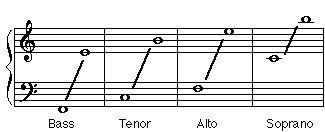Voice

The most important tool in learning to use your voice as a musical instrument is your ear.
You need to be able to tell, first of all, when two pitches are the same and when they are different. Secondly, you need to be able to tell when a given pitch is higher or lower than another pitch. Finally, learning to sing is a combination of hearing the notes in your head and a certain amount of muscle-memory in terms of what it takes to make your voice reproduce that pitch.
Note: In general, men's voices tend to be approximately one octave lower than the voices of women and children. In the examples above, the pitch on the left is one octave below the pitch on the right. Choose the pitch that fits most comfortably within your range.
Following is the Grand Staff that you saw earlier in this course. Click on the note names and try to match each pitch with your voice. Some pitches will be completely outside your range; work this exercise until you have determined what range of pitches is most comfortable for your voice.

In general, voices tend to fall into four major categories: Soprano, Alto, Tenor, and Bass. Compare your results from the previous excercise with the following chart:
